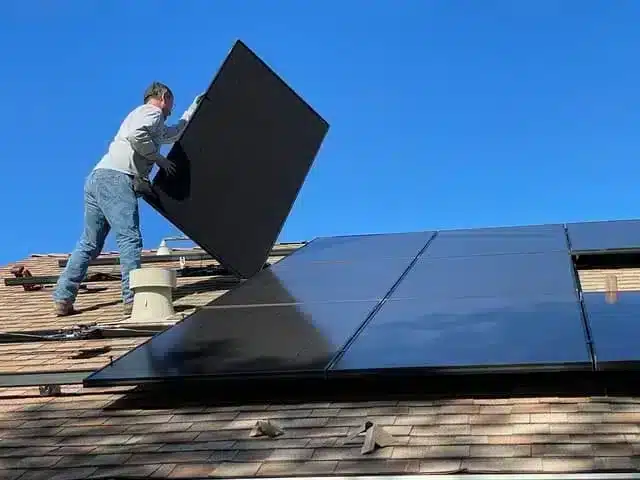
Ahhh. What a beautiful sight.
The sun bounces off those newly installed rooftop PV panels and fills us with the warm, fuzzy feeling of helping the world embrace green energy. We dream of covering every roof with solar panels – of kick-starting the solar revolution and building a big, successful company along the way.
But alas, as solar installers, it’s our job to tread lightly and meticulously. A bad installation can turn into an expensive nightmare for homeowners, installation teams, and the entire solar community, so here are a few common installation problems to consider as the solar season begins.
A Poorly Assessed Roof
As the most common spot for PV installations, the roof is the main culprit when things go wrong. And of course, by definition, the roof is usually connected to a building, which means one wrong move can seriously impact the entire structure.
That’s why a proper assessment of the roof needs to be our number one priority, not the closing of our sale. While we all want to scale and grow, it’s important to remember that some roofs simply aren’t well-designed for PV installations.
Trying to fight that is just asking for trouble.
Here are some of the elements to consider in your assessment:
- Age: Today’s solar panels boast a lifespan of about 20 years, but if a homeowner needs to structurally change their roof before then, you may be opening the door to a slew of issues and complications.
- Strength: Solar panels add considerable weight and stress to the roof, so make sure it’s sturdy and healthy enough to support the additional weight and strain. This holds especially true if you’re working on an older roof.
- Condition: Beyond the wear and tear of the initial installation, the roof needs to be in good enough condition to support regular system maintenance throughout its lifetime.
If the homeowner’s roof isn’t up to snuff, consider partnering with a local roofing company to offer combined offers, including a new roof or roof repair and a solar installation in a package deal. This way, you won’t have to turn down any sales; you’ll help another local business and ensure that your client has a quality roof and solar system that they can use for the next 10 – 20 years with fewer issues down the road.
Careless, Sloppy Installation
While roofs may seem sturdy and impervious, they’re actually complex, interconnected structures that require careful consideration and care. Dragging panels or racks across the roof, being careless about our heavy tools, or leaving junk behind can result in holes, leaks, clogged drainage systems, moisture buildup, ice dams, and massive damage to the roof’s structural integrity.
This is especially important to consider if you follow our advice and partner with a local roofing company or contractor. You definitely don’t want to ruin their hard work with a careless installation.
Ensure that your installation crew is up-to-date in all their certifications and has received proper hands-on solar training before sending them out to the job site. You’ll also want to set up regular performance reviews for your crew and head to as many job sites as possible to assess their workmanship and ensure that they work safely and efficiently.
Keep in mind that your salespeople and installers are the faces of your company. If they’re not doing a good job, it will reflect poorly on you and could cost you referrals and future sales if your team isn’t careful.
You’re proud of your installation company, and your employees should be proud of their work as well. Ensure that everyone has the right skills, training, and tools to do the best job they can. After all, doing a good job and offering a top-tier service is one of the best ways to grow a business and succeed in such a competitive industry.
Installing Panels in Shaded Areas
If a homeowner’s trees will be a problem, tell them. If some panels need to be installed in partially shaded areas, the client’s entire system will suffer and might not perform as well as if exposed to direct sunlight all day long.
Most people don’t realize that solar panels are most commonly installed in series, which means that one shaded panel will affect the entire system’s performance. A regular person might assume that a little shade won’t hurt the overall output of their system, so they might not consider that removing problem trees will likely be necessary if they want a functional solar system.
There are two solutions to this problem:
- Avoid installing panels on partially shaded areas of the roof.
- Explain how solar panel strings work to the homeowner, and ask them to trim back or cut down any trees that may affect system performance.
You’re the expert here, and you need to make sure that the system you’re installing can generate enough solar energy to meet your client’s electricity needs. Additionally, if you’re operating in an area that offers Net Metering, installing a system that performs well will further benefit the homeowner if they can sell back some excess power to the grid for credits.
Alternatively, if the shading issues aren’t caused by trees and rather neighboring buildings or mountains, it might be better to offer a ground-mounted system if possible or politely decline the job entirely. Sometimes no system at all is better than a poorly performing one that might damage your reputation as a trustworthy installer.
Keep in mind that both the homeowner and the installer want the best possible outcome for every solar project. If you’re not making it clear what needs to be done in order to achieve that, you will fall victim to yet another common pitfall of solar panel installation.
Not Using System Monitoring Tools
As solar technology improves, so do the tools and systems we have in place to make sure everything is running properly and efficiently. Nowadays, not using a system monitoring tool yourself or setting your clients up with the right software and applications is a big faux pas.
System monitoring tools help solar contractors monitor their installations remotely and can help homeowners diagnose any issues they may be having with their solar systems. On the other hand, setting up your clients with their own system monitoring apps can help them monitor their own systems and know when to reach back out to their solar provider for maintenance or repairs.
These tools also provide a bird’s eye view of a solar system’s production and can be set up to display daily, monthly, or yearly performance data for a system.
Generally, there are three different kinds of solar system monitoring tools available:
- Tools made by solar panel or other equipment manufacturers.
- Tools created and provided by the installation company itself.
- Standalone monitoring equipment that can be sold as an add-on to a solar system.
Enphase Energy, which manufacturers microinverters, for example, offers access to its Enlighten monitoring platform, where users can monitor production data and other information from both mobile and web apps. This platform not only works as a monitoring tool but also provides homeowners with an easy way to connect with their solar installers, make warranty claims, and share production data through social media.
Whether you inform your clients about manufacturer tools, have your own, or offer to install standalone monitoring equipment alongside your systems, it’s important to offer at least one of these options to all of your clients if you don’t want to fall victim to this common pitfall.
Wild things
Solar energy might be a big win for Mother Earth, but let’s be clear –that doesn’t always mean she’ll cooperate. Racks and panels can create attractive nesting spots for birds of all feathers, which means excrement build-up and can damage wires and hardware. Try using plastic owl decoys to scare them off. If that doesn’t work, bird spikes can also be used to keep them at bay.
On the other hand, rodents can cause serious damage to the internal elements of the system by chewing wires or making their way into components. Professional, proactive installers will think ahead by setting up squirrel guards, screens, or wires alongside the panels to keep damage to a minimum.
Thankfully, none of these solutions will harm the wildlife and protected species in your area. Consider what tends to burrow or roost in your service area and make sure to have all the right equipment on hand to protect your fresh installation from any critters that might be interested in turning it into a home.
In Closing
As solar installers, we help customers mitigate risk and get the most out of their solar experience, so we suggest you always communicate transparently about the different steps you’re taking to assess and prevent damage. This might mean installing a monitoring system that will quickly notify you if anything interferes with production, but it might also mean telling a client their roof isn’t a good fit for solar.
And yes, that means one less sale under your belt.
But trust us, that extra sale isn’t worth your reputation.



 United States
United States Germany/Austria
Germany/Austria Brazil
Brazil Netherlands
Netherlands